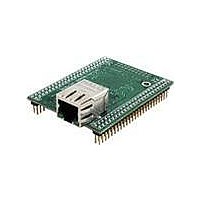MOD5234-100IR NetBurner Inc, MOD5234-100IR Datasheet - Page 160

MOD5234-100IR
Manufacturer Part Number
MOD5234-100IR
Description
MOD5234 10/100 ETHERNET MODULE
Manufacturer
NetBurner Inc
Type
Controllers & Processorsr
Datasheets
1.MOD5272-100IR.pdf
(3 pages)
2.MOD5234-100IR.pdf
(4 pages)
3.MOD5234-100IR.pdf
(754 pages)
Specifications of MOD5234-100IR
Interface
I²C, SPI, UART
Voltage - Supply
2.5V
Mounting Type
Surface Mount
Package / Case
Module
Product
Modules
Lead Free Status / RoHS Status
Lead free / RoHS Compliant
Data Format
-
Baud Rates
-
Lead Free Status / Rohs Status
Lead free / RoHS Compliant
Other names
Q4483564
- Current page: 160 of 754
- Download datasheet (13Mb)
Clock Module
7.4.4
Frequency modulation is useful for spreading the energy over a broader frequency spectrum in
order to reduce EMI.
In normal PLL clock mode, the default synthesis mode is without frequency modulation enabled.
When frequency modulation (FM) is enabled three parameters must be set to generate the desired
level of modulation: the RATE, DEPTH, and EXP bit fields of the SYNCR. RATE and DEPTH
determine the modulation rate and the modulation depth. The EXP field controls the FM
calibration routine described in
equation that shows how to obtain the values to be programmed for EXP is as follows (see
Section 7.4.5, “Frequency Modulation Depth Calibration,”
Figure 7-6
modulation hardware. The modulation waveform is always a triangle wave and its shape is not
programmable.
Note, the modulation rates given are specific to a reference frequency of 8 MHz.
where Q = {40,80} giving modulation rates of 200 kHz, and 100 kHz. Therefore, the utilization of
a non 8 MHz reference will result in scaled modulation rates.
The following steps should be used for proper programming of the frequency modulation mode.
These steps ensure proper operation of the calibration routine and prevent frequency overshoot
from the sequence.
7-16
5. Monitor the LOCK flag in SYNSR. When the PLL achieves lock, write the RFD value
6. If frequency modulation was enabled initially, it can be re-enabled following the steps
1. Determine the appropriate value for the EXP field, based upon the selected MFD and
2. Disable modulation by clearing the DEPTH field in the SYNCR.
3. Monitor LOCK bit. Do not proceed until the PLL is locked in non-modulation mode.
from step 1 to the RFD field of the SYNCR. This changes the system clocks frequency to
the required frequency.
listed in
desired depth, in the synthesizer control register (SYNCR), as shown in the equation above.
Write this value to the EXP field of the SYNCR. The MFD should be programmed to the
appropriate value prior to Step 2.
Programming the Frequency Modulation
illustrates the affects of the parameters and the modulation waveform built into the
Keep the maximum system clock frequency below the limit given in
the Electrical Characteristics.
Section 7.4.4, “Programming the Frequency Modulation.”
Section 7.4.5, “Frequency Modulation Depth Calibration.”
MCF5235 Reference Manual, Rev. 2
EXP
=
(
------------------------------------------------------- -
2× MFD
NOTE
(
100
+
2
)×M×P
for details):
)
Freescale Semiconductor
F
mod
=
F
ref
The
⁄
Q
Related parts for MOD5234-100IR
Image
Part Number
Description
Manufacturer
Datasheet
Request
R

Part Number:
Description:
MCU, MPU & DSP Development Tools MOD5234 MODULE
Manufacturer:
NetBurner Inc
Datasheet:

Part Number:
Description:
MCU, MPU & DSP Development Tools MOD5234 Core Module Development Kit
Manufacturer:
NetBurner Inc
Datasheet:

Part Number:
Description:
BOARD SERIAL-ETHERNET 512K FLASH
Manufacturer:
NetBurner Inc
Datasheet:

Part Number:
Description:
PROCESSOR MODULE FLASH MOD5272
Manufacturer:
NetBurner Inc
Datasheet:

Part Number:
Description:
PROCESSOR MODULE 512KB FLASH
Manufacturer:
NetBurner Inc
Datasheet:

Part Number:
Description:
DUAL PORT SERIAL-ETHERNET
Manufacturer:
NetBurner Inc
Datasheet:

Part Number:
Description:
PROCESSOR MODULE FLASH
Manufacturer:
NetBurner Inc
Datasheet:

Part Number:
Description:
PROCESSOR MODULE 512KB FLASH
Manufacturer:
NetBurner Inc
Datasheet:

Part Number:
Description:
KIT DEVELOP NETWORK FOR MOD5282
Manufacturer:
NetBurner Inc
Datasheet:

Part Number:
Description:
KIT DEVELOP NETWORK FOR MOD5272
Manufacturer:
NetBurner Inc
Datasheet:

Part Number:
Description:
DUAL PORT SERIAL-ETHERNET
Manufacturer:
NetBurner Inc
Datasheet:

Part Number:
Description:
Ethernet Modules & Development Tools 32 Bit 66MHz 40 Pin DIP Industrial Temp
Manufacturer:
NetBurner Inc
Datasheet:

Part Number:
Description:
Ethernet ICs 32bit 147MHz CAN-to- Ethnt Device IndTemp
Manufacturer:
NetBurner Inc
Datasheet:










